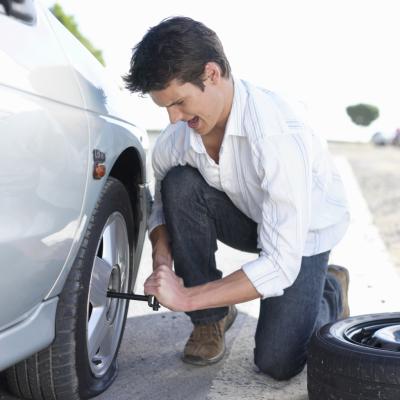
Just as there is more than one way to skin a cat, there is also more than one way to change a car tire. Most modern cars come equipped with the tools to replace the tire on the side of the road. Professional repair shops have better equipment for performing the job. Either way, tools are necessary if a tire needs to be changed.
The car should already have a lug wrench sized for the lug nuts on the vehicle. Some refer to it as a tire iron. While it is not the easiest means for removing lug nuts, it can get the job done. Larger, more common lug wrenches, known as four-ways, are shaped like an “X” and have different sized lug sockets at each end. Four ways can provide better leverage, due to their larger size. Best of all is the professional air gun, a drill-like device that uses an impact socket and pneumatic power to spin the lug nuts on and off in a matter of seconds.
Raising the tire off the ground is a must when changing it. Just as with the tire iron, all modern vehicles come with a rudimentary jack that can lift the vehicle in a pinch. In a more controlled environment, the vehicle is likely raised with a floor jack or bottle jack. The floor jack can be rolled under the vehicle and used to raise the vehicle in a few quick pumps of the jack’s handle. A bottle jack, named as such because its shape resembles a stout bottle, must be positioned by hand, and can also raise a vehicle up faster than the factory-supplied jack.
In order to prevent the lug nuts from screwing back off the wheel studs while driving, it is best to do the final lug nut reinstallation with a torque wrench. This wrench allows the user to determine a pre-set amount of torque to be applied to the lug nuts. If the lug nuts are torqued below the specifications, they can come loose and cause the wheel to part ways with the vehicle unexpectedly. If the lug nuts are over-torqued, the brake rotor can sustain damage from warping due to the amount of excessive strain placed on it by the over-torqued nuts.